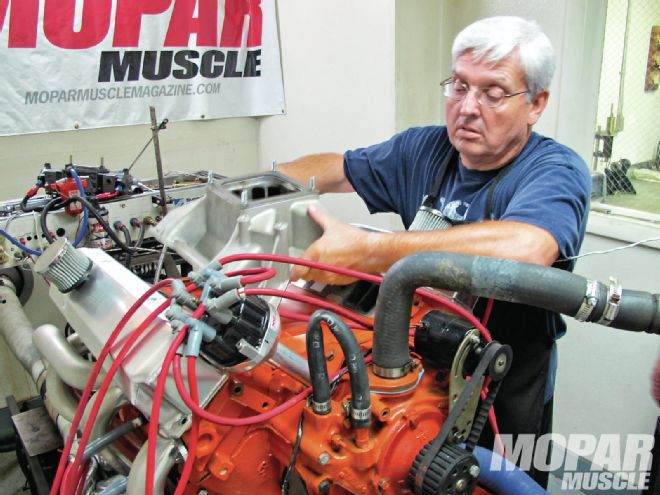
Have you ever wondered if the parts you’re using are the best ones for your application? We sure have, which is why we take advantage of any opportunity to test a variety of parts and pass along the results. So, while we had our standard bore, standard stroke 440 bolted to the dyno at Auto Performance Engines, we decided it would be a good time to see which intake manifold worked best with this combination. We all have our own ideas about what style intake is best for a certain engine, and there’s no doubt that exotic, hand-fabricated tunnel ram intakes make big peak numbers. The problem is they don’t fit under the hood. Alternatively, stock intake manifolds fit inside the engine bay nicely, but their dual-plane design isn’t usually the best option for modified engines.
01 Replacing your Mopar’s stock intake manifold with an aftermarket unit is an easy way to pick up power and save weight. With so many intakes available, however, which one is right for your big-block? ">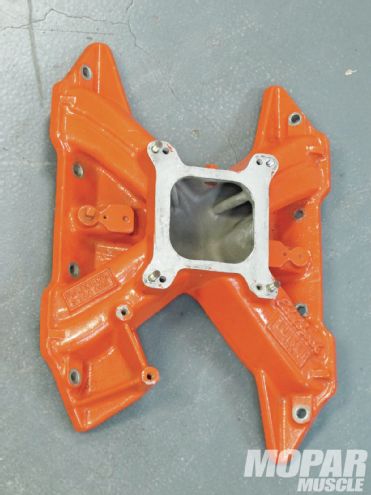 <strong>01</strong> Replacing your Mopar’s stock intake manifold with an aftermarket unit is an easy way to pick up power and save weight. With so many intakes available, however, which one is right for your big-block?
<strong>01</strong> Replacing your Mopar’s stock intake manifold with an aftermarket unit is an easy way to pick up power and save weight. With so many intakes available, however, which one is right for your big-block?
Intake manifold designs have been numerous and varied throughout automotive history, and Chrysler has always been one of the most innovative companies when it comes to engineering intakes to make impressive power and torque. In fact, some of the intake manifolds engineered by the Chrysler Corporation could be considered even more exotic than aftermarket components, like the long-ram dual-quad intake installed on RB engines during the early ’60s. This intake actually placed a carburetor over the inner fender opposite the bank of cylinders it fed, and the long-ram design made killer torque in the 2,500-3,500 rpm range. Since then, Chrysler has designed a number of notable, multi-carb intakes for their V-8 engines, but the most widely used performance intakes used by Chrysler were of the dual-plane, single four-barrel design.
02 The 440 we’re using for our test is typical of a Mopar street/strip or bracket engine. With forged pistons, a Comp sold lifter cam, Comp roller rockers, and cleaned up 915 casting cylinder heads, this combination makes good power without breaking the bank. For the details of this 440, be sure to check out the April ’13 issue of Mopar Muscle.">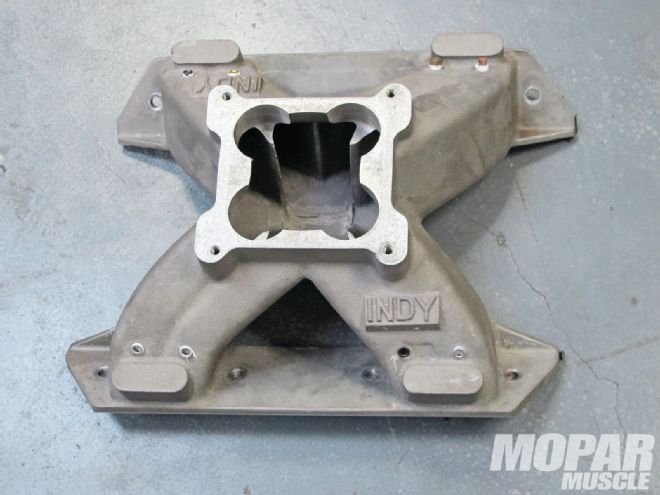 <strong>02</strong> The 440 we’re using for our test is typical of a Mopar street/strip or bracket engine. With forged pistons, a Comp sold lifter cam, Comp roller rockers, and cleaned up 915 casting cylinder heads, this combination makes good power without breaking the bank. For the details of this 440, be sure to check out the April ’13 issue of Mopar Muscle.
<strong>02</strong> The 440 we’re using for our test is typical of a Mopar street/strip or bracket engine. With forged pistons, a Comp sold lifter cam, Comp roller rockers, and cleaned up 915 casting cylinder heads, this combination makes good power without breaking the bank. For the details of this 440, be sure to check out the April ’13 issue of Mopar Muscle.
To understand why Chrysler utilized the dual-plane intake almost exclusively on the engines they produced during the muscle car era, we must first understand the intended market for these cars. Not everyone who purchased a Road Runner or Super Bee was interested in maximum performance, as the average customer wanted a cool looking, fast car that would turn heads as well as get them to work and back reliably. The dual-plane intake manifold is ideal for this type of vehicle, because while it does have some performance limitations, it also ensures smooth operation in all climates, and offers a broad torque curve, which is what most drivers notice when accelerating from a stop light or doing a burnout. That being said, most performance enthusiasts almost immediately removed the factory intake manifold in favor of a lighter, and better flowing, aluminum aftermarket intake once they had their car home from the dealership.
03 To establish a baseline, we initially installed a factory Chrysler intake manifold on our 440. To mount our Holley 950-cfm Ultra-HP carb, we needed a one-inch spacer due to interference with the intakes choke provision. "> <strong>03</strong> To establish a baseline, we initially installed a factory Chrysler intake manifold on our 440. To mount our Holley 950-cfm Ultra-HP carb, we needed a one-inch spacer due to interference with the intakes choke provision.
<strong>03</strong> To establish a baseline, we initially installed a factory Chrysler intake manifold on our 440. To mount our Holley 950-cfm Ultra-HP carb, we needed a one-inch spacer due to interference with the intakes choke provision.
Aftermarket companies realized early on that they could offer a substantial performance improvement to car owners by designing better intake manifolds for their vehicles. Nearly all aftermarket intakes are made from lightweight aluminum, and many replacement intakes are of the same dual-plane design as factory intakes. The problem here is that the dual-plane design limits performance, since each cylinder only gets to benefit from half of the carburetor’s available induction flow. Modern dual-plane intakes resolve this issue with a notch in the plenum divider, but for real performance, especially if the engine is modified with an aftermarket cam, headers, a larger carburetor, or even cylinder head porting, an intake manifold of single-plane, or open plenum design, is the best choice.
04 The aftermarket intakes we’re testing don’t have provisions for a heat crossover, so we fabricated block-off plates from thin sheetmetal for our factory intake. Fel-Pro also offers intake valley gaskets that take care of this for you, but we didn’t want to waste one of those on our test engine since this gasket will be trashed after our testing. ">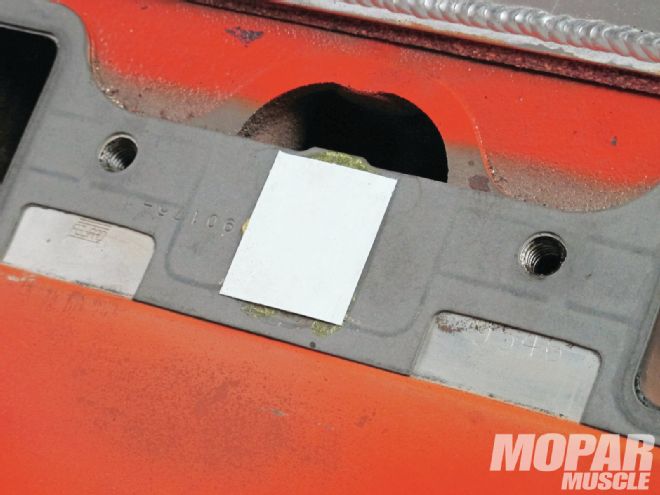 <strong>04</strong> The aftermarket intakes we’re testing don’t have provisions for a heat crossover, so we fabricated block-off plates from thin sheetmetal for our factory intake. Fel-Pro also offers intake valley gaskets that take care of this for you, but we didn’t want to waste one of those on our test engine since this gasket will be trashed after our testing.
<strong>04</strong> The aftermarket intakes we’re testing don’t have provisions for a heat crossover, so we fabricated block-off plates from thin sheetmetal for our factory intake. Fel-Pro also offers intake valley gaskets that take care of this for you, but we didn’t want to waste one of those on our test engine since this gasket will be trashed after our testing.
Single-plane intakes, as the name implies, allow all four barrels of the carburetor to feed one plenum area, which in turn feeds all of the engine’s eight cylinders. Drawbacks to this design include a tendency for uneven fuel distribution when the engine is cold, and engines with single-plane intake manifolds can be cold natured, but for overall performance the single-plane intake manifold is widely regarded as the best all-around choice for a modified, high-performance engine.
05 With our stock intake and Holley 950 carburetor installed, we made a baseline pull on our 440. This engine has a stout cam, around ten to one compression, mild head porting, and headers, so it was little surprise that the factory intake’s performance was sub-par. ">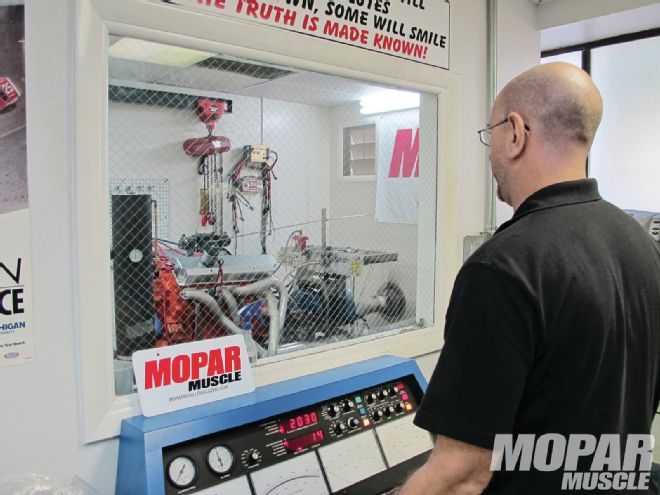 <strong>05</strong> With our stock intake and Holley 950 carburetor installed, we made a baseline pull on our 440. This engine has a stout cam, around ten to one compression, mild head porting, and headers, so it was little surprise that the factory intake’s performance was sub-par.
06 The baseline pull on our 440 using the stock intake netted 412 peak horsepower. While this is significantly higher than the 375 horsepower advertised by Chrysler, we knew our aftermarket intakes would improve performance. ">
<strong>05</strong> With our stock intake and Holley 950 carburetor installed, we made a baseline pull on our 440. This engine has a stout cam, around ten to one compression, mild head porting, and headers, so it was little surprise that the factory intake’s performance was sub-par.
06 The baseline pull on our 440 using the stock intake netted 412 peak horsepower. While this is significantly higher than the 375 horsepower advertised by Chrysler, we knew our aftermarket intakes would improve performance. ">
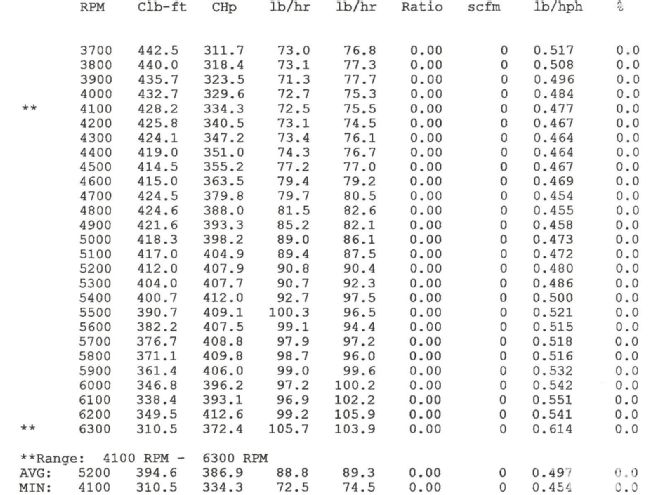 <strong>06</strong> The baseline pull on our 440 using the stock intake netted 412 peak horsepower. While this is significantly higher than the 375 horsepower advertised by Chrysler, we knew our aftermarket intakes would improve performance.
07 The first aftermarket intake we tested was an Edelbrock Victor 440. This is an older design, known for making big peak torque.">
<strong>06</strong> The baseline pull on our 440 using the stock intake netted 412 peak horsepower. While this is significantly higher than the 375 horsepower advertised by Chrysler, we knew our aftermarket intakes would improve performance.
07 The first aftermarket intake we tested was an Edelbrock Victor 440. This is an older design, known for making big peak torque.">
 <strong>07</strong> The first aftermarket intake we tested was an Edelbrock Victor 440. This is an older design, known for making big peak torque.
08 As the dyno sheet shows, the Edelbrock Torker intake manifold made big improvements over our baseline with the stock intake. Peak torque was up to 465.6 lb-ft and peak power was up to 452.7 horsepower. It’s amazing how a simple intake swap really woke up our 440.">
<strong>07</strong> The first aftermarket intake we tested was an Edelbrock Victor 440. This is an older design, known for making big peak torque.
08 As the dyno sheet shows, the Edelbrock Torker intake manifold made big improvements over our baseline with the stock intake. Peak torque was up to 465.6 lb-ft and peak power was up to 452.7 horsepower. It’s amazing how a simple intake swap really woke up our 440.">
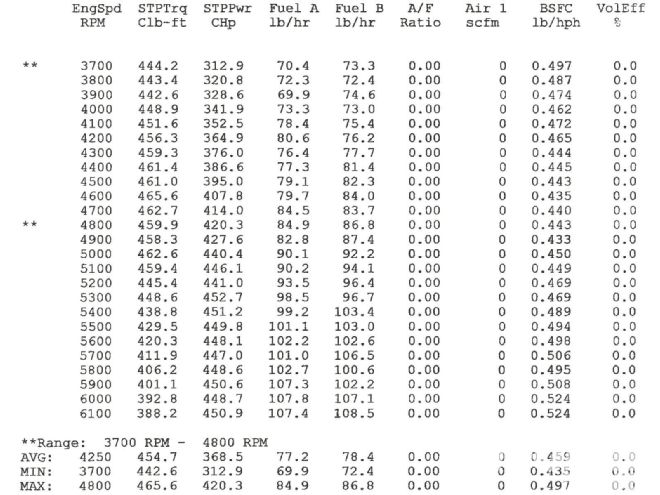 <strong>08</strong> As the dyno sheet shows, the Edelbrock Torker intake manifold made big improvements over our baseline with the stock intake. Peak torque was up to 465.6 lb-ft and peak power was up to 452.7 horsepower. It’s amazing how a simple intake swap really woke up our 440.
<strong>08</strong> As the dyno sheet shows, the Edelbrock Torker intake manifold made big improvements over our baseline with the stock intake. Peak torque was up to 465.6 lb-ft and peak power was up to 452.7 horsepower. It’s amazing how a simple intake swap really woke up our 440.
The 440 we’re testing in this article is just such an engine, as it has been modified with forged flat-top pistons, a Comp Cams solid lifter, flat-tappet camshaft, Comp roller rockers, and mild porting to the 915 casting cylinder heads. We built this engine on a tight budget (the details are in the April ’13 issue of Mopar Muscle) and have used our 440 as a dyno mule to test several components since the build. While we had the engine on the dyno, however, we thought it would be a good time to see which of the wide variety of single-plane intakes would make the best peak, and average, torque and horsepower.
09 The Holley Street Dominator is a redesigned version of their single-plane intake, and is flanged for a 4150 base carburetor (don’t let the Dominator name fool you). This intake is known for improving average horsepower and torque, and fits nicely under the hood of most Mopar body styles. ">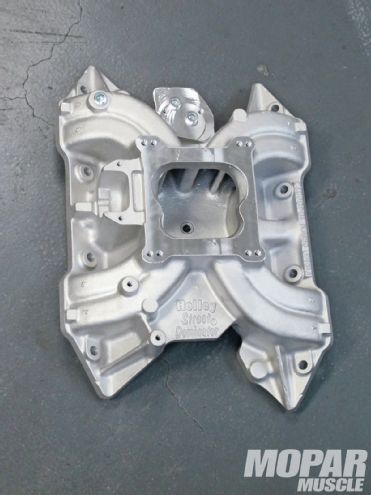 <strong>09</strong> The Holley Street Dominator is a redesigned version of their single-plane intake, and is flanged for a 4150 base carburetor (don’t let the Dominator name fool you). This intake is known for improving average horsepower and torque, and fits nicely under the hood of most Mopar body styles.
10 The results show horsepower improved to a peak of 454.3 with the Holley Street Dominator intake. Peak torque was down slightly, but average torque numbers still looked stout. ">
<strong>09</strong> The Holley Street Dominator is a redesigned version of their single-plane intake, and is flanged for a 4150 base carburetor (don’t let the Dominator name fool you). This intake is known for improving average horsepower and torque, and fits nicely under the hood of most Mopar body styles.
10 The results show horsepower improved to a peak of 454.3 with the Holley Street Dominator intake. Peak torque was down slightly, but average torque numbers still looked stout. ">
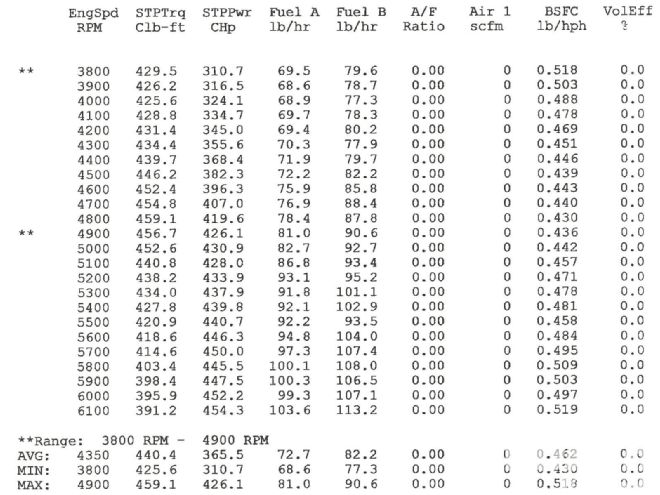 <strong>10</strong> The results show horsepower improved to a peak of 454.3 with the Holley Street Dominator intake. Peak torque was down slightly, but average torque numbers still looked stout.
<strong>10</strong> The results show horsepower improved to a peak of 454.3 with the Holley Street Dominator intake. Peak torque was down slightly, but average torque numbers still looked stout.
We already decided that our 440 would benefit from an aftermarket, single-plane intake manifold, so we needed to decide which intakes to test. In order to validate our results, we also needed to establish a baseline for the tests, which we did by initially dynoing our engine with a factory, 1969 440 HP cast-iron intake manifold. With our baseline established, we then tested single-plane aluminum intake manifolds from Holley, Edelbrock, Mopar Performance, and Indy Cylinder Head.
11 The Mopar Performance M-1 intake manifold has long been a favorite of big-block engine builders. This intake has a huge plenum, which large displacement engines seem to like. ">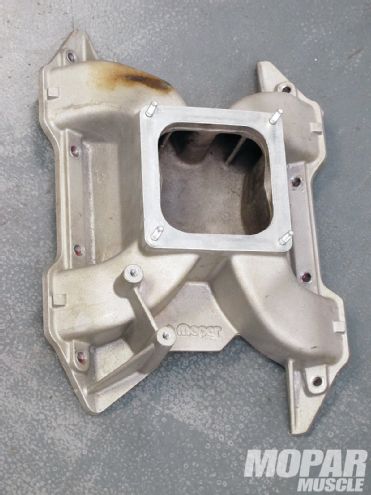 <strong>11</strong> The Mopar Performance M-1 intake manifold has long been a favorite of big-block engine builders. This intake has a huge plenum, which large displacement engines seem to like.
12 Our 440 test engine really seemed to like the M-1 intake as power was up throughout the rpm range. Peak torque improved to 466.6 lb-ft and peak horsepower was up to 460.6.">
<strong>11</strong> The Mopar Performance M-1 intake manifold has long been a favorite of big-block engine builders. This intake has a huge plenum, which large displacement engines seem to like.
12 Our 440 test engine really seemed to like the M-1 intake as power was up throughout the rpm range. Peak torque improved to 466.6 lb-ft and peak horsepower was up to 460.6.">
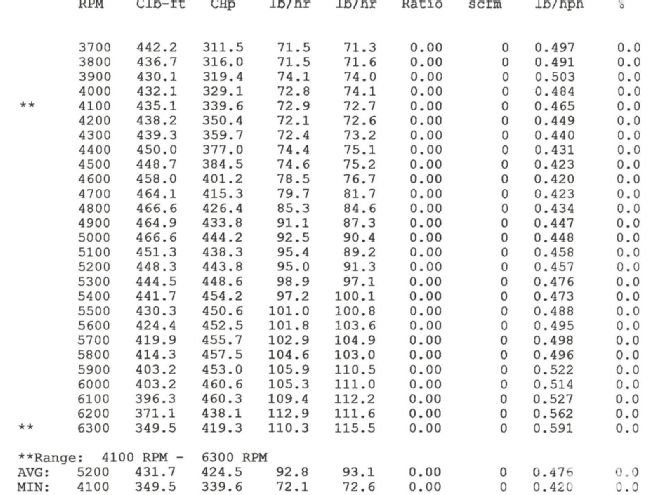 <strong>12</strong> Our 440 test engine really seemed to like the M-1 intake as power was up throughout the rpm range. Peak torque improved to 466.6 lb-ft and peak horsepower was up to 460.6.
13 Indy Cylinder Head manufactures several intakes for the big-block Mopar engine, for various power levels, so we decided to test their 440-13-3 on our engine. This is a Dominator flange intake, but fortunately the Holley Ultra-HP carb has slotted mounting provisions so it will fit both 4150 and 4500 intakes. ">
<strong>12</strong> Our 440 test engine really seemed to like the M-1 intake as power was up throughout the rpm range. Peak torque improved to 466.6 lb-ft and peak horsepower was up to 460.6.
13 Indy Cylinder Head manufactures several intakes for the big-block Mopar engine, for various power levels, so we decided to test their 440-13-3 on our engine. This is a Dominator flange intake, but fortunately the Holley Ultra-HP carb has slotted mounting provisions so it will fit both 4150 and 4500 intakes. ">
 <strong>13</strong> Indy Cylinder Head manufactures several intakes for the big-block Mopar engine, for various power levels, so we decided to test their 440-13-3 on our engine. This is a Dominator flange intake, but fortunately the Holley Ultra-HP carb has slotted mounting provisions so it will fit both 4150 and 4500 intakes.
14 We must admit the Indy intake we used was one we had from a previous project and was at a disadvantage as the ports were increased to the Max-Wedge size, creating a port misalignment with the intake ports on the heads. Even so, the Indy intake performed well, and would really show its potential if used with aftermarket cylinder heads. ">
<strong>13</strong> Indy Cylinder Head manufactures several intakes for the big-block Mopar engine, for various power levels, so we decided to test their 440-13-3 on our engine. This is a Dominator flange intake, but fortunately the Holley Ultra-HP carb has slotted mounting provisions so it will fit both 4150 and 4500 intakes.
14 We must admit the Indy intake we used was one we had from a previous project and was at a disadvantage as the ports were increased to the Max-Wedge size, creating a port misalignment with the intake ports on the heads. Even so, the Indy intake performed well, and would really show its potential if used with aftermarket cylinder heads. ">
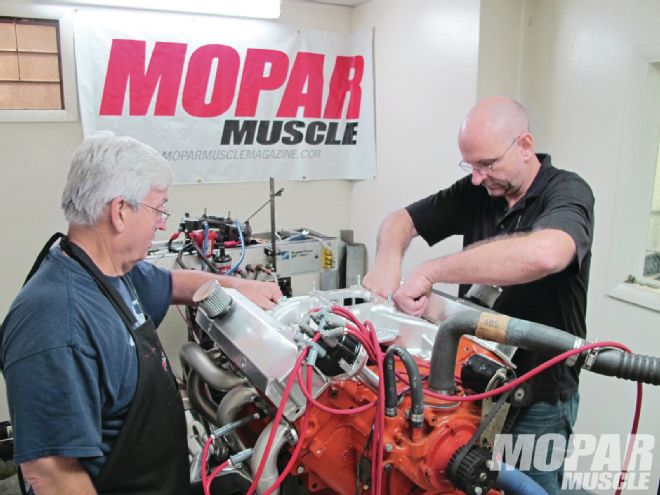 <strong>14</strong> We must admit the Indy intake we used was one we had from a previous project and was at a disadvantage as the ports were increased to the Max-Wedge size, creating a port misalignment with the intake ports on the heads. Even so, the Indy intake performed well, and would really show its potential if used with aftermarket cylinder heads.
<strong>14</strong> We must admit the Indy intake we used was one we had from a previous project and was at a disadvantage as the ports were increased to the Max-Wedge size, creating a port misalignment with the intake ports on the heads. Even so, the Indy intake performed well, and would really show its potential if used with aftermarket cylinder heads.
During our intake test, we utilized the same Holley 950-cfm Ultra-HP carburetor on all of the intakes. We’ve found this line of carbs to run great out of the box, and kept jetting the same for all of the test pulls. We also kept the engine’s ignition timing the same for all the pulls, as well as valve lash, to reduce the number of variables during our testing. Luckily, the big-block Mopar doesn’t have any water jackets running through the intake manifold, making it easy to perform intake swaps without draining coolant. All told, it took us about a day on the dyno to initially tune our engine, and then to test each of the different intake manifolds and log the results.
15 The Edelbrock Victor 440 intake was the last manifold we tested and is Edelbrock’s latest offering in the single-plane market. This intake looks great, has decent plenum volume, and long runners. ">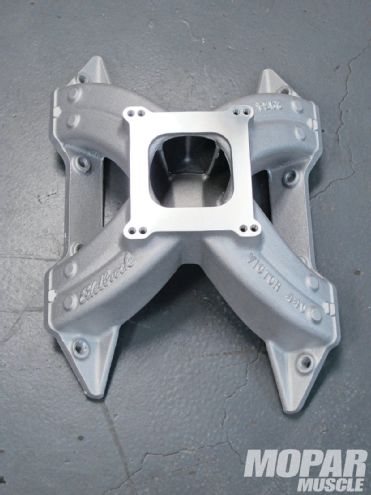 <strong>15</strong> The Edelbrock Victor 440 intake was the last manifold we tested and is Edelbrock’s latest offering in the single-plane market. This intake looks great, has decent plenum volume, and long runners.
16 With the Edelbrock Victor 440 intake on our big-block, peak torque of 459.5 lb-ft was recorded at 4,700 rpm. Peak power was 453.1 at 6,100 rpm. ">
<strong>15</strong> The Edelbrock Victor 440 intake was the last manifold we tested and is Edelbrock’s latest offering in the single-plane market. This intake looks great, has decent plenum volume, and long runners.
16 With the Edelbrock Victor 440 intake on our big-block, peak torque of 459.5 lb-ft was recorded at 4,700 rpm. Peak power was 453.1 at 6,100 rpm. ">
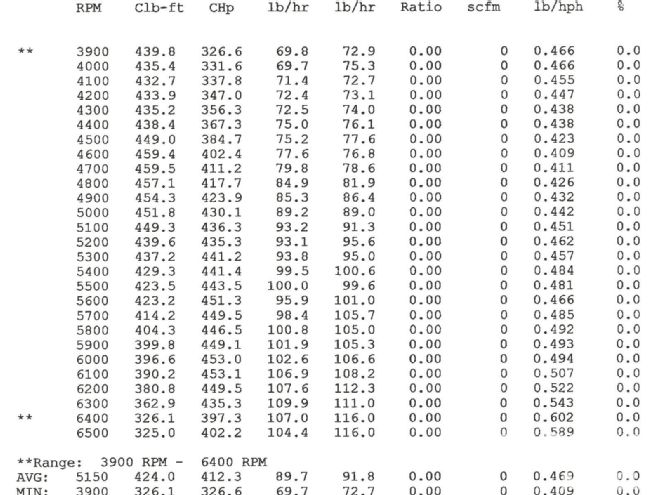 <strong>16</strong> With the Edelbrock Victor 440 intake on our big-block, peak torque of 459.5 lb-ft was recorded at 4,700 rpm. Peak power was 453.1 at 6,100 rpm.
<strong>16</strong> With the Edelbrock Victor 440 intake on our big-block, peak torque of 459.5 lb-ft was recorded at 4,700 rpm. Peak power was 453.1 at 6,100 rpm.
Were we surprised by any of our test results? Well, we’ve been doing this a long time so we knew that each of the intakes we tested would outperform the factory intake we used for our baseline. We also know that replacing the heavy cast-iron intake with an aluminum intake will improve performance by simply saving weight, even if no extra power is gained. The factory intake we used for our baseline is regarded as the best offering from the factory, but even so it falls way short of the Edelbrock Torker, Edelbrock Victor, Holley Street Dominator, Mopar Performance M-1, or Indy Cylinder Head intake manifolds that we tested. But enough about theory—follow along as we show you which intakes performed best on our 440 dyno engine.

Any time you test a part or series of parts, you need to remember that the part must match the entire combination. Our particular 440 seemed to really like the Mopar Performance M1 intake manifold, but that doesn’t mean the other intakes performed poorly, just that our combination was most closely matched to the M1. For example, in subsequent tests on this engine the Indy intake made big numbers when matched to aftermarket heads with Max-Wedge intake port size, and the Victor 440 intake performed best with out of the box 440 Source aluminum cylinder heads. We learned that any aftermarket intake will outperform a factory intake manifold, and also that the Edelbrock Torker held its own with the best average torque and second best average horsepower numbers of the intakes we tested. Remember that all the parts of your engine must be matched properly for optimum performance, and that the results we showed here may not be the same for your application. When in doubt, we suggest calling an engine builder who has experience with the combination you're building, or taking advantage of the many tech help lines available from the various aftermarket manufacturers.